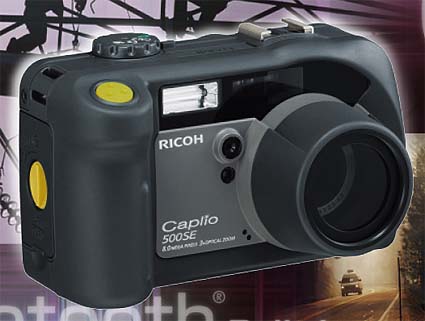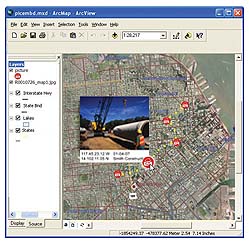On January 25, 2008, Ricoh introduced the 8.1 megapixel Ricoh 500SE Digital Camera with integrated barcode scanning capabilities to the US market. Designed for barcode-based workflows that require high-quality images, the 500SE, also known as the Ricoh Caplio 500SE model W in other markets, provides an easy to use all-in-one ruggedized solution that overcomes the image quality shortfalls of alternative systems.

Ricoh is actually an interesting case. The company offers a lineup of almost 20 digital cameras covering virtually every aspect of the market. However, for some reason Ricoh does not market those in the US and concentrates on special applications instead.
What Ricoh is trying to address with the US-spec 500SE is the relationship between image quality and bar code reading. There are handheld computers and scanners whose imagers are essentially cameras and can capture images. However, those devices are bar code readers first and cameras second, if at all. Ricoh turns this around and makes a "camera first" approach.
The 500SE supports all popular 1D barcodes and can scan barcodes optically directly through its lens or it may be augmented with an extra-cost U$349 SE-4 laser-scanning module for workflows that require laser scanning. Either way, the scanned barcode data is then embedded into the JPEG file. A special data area in the JPEG lets you enter more user-defined information, such as name, job number, etc.

All of this results in what Ricoh calls a "data image" with "meta data." Once transferred to a computer, the embedded data is extracted and can be used to perform a variety of automated tasks. Images may, for example, be renamed based on the barcode data, data could be used to imprint information on the image itself, or it could be used to enter records into a database. See the example above.
But a bit more about the camera itself. The 500SE has integrated 802.11b/g WiFi and Bluetooth 2.0 + EDR to wirelessly transfer image files directly to handheld terminals or servers. Its 3X optical zoom lens has a focal length equivalent to 29-85mm for 35mm film, i.e. it starts wide. This makes it easier to get a comprehensive image of closeby subjects and scenes. The 2.5-inch LCD is large enough but its 153k pixel resolution is a bit low. The camera measures 5.3 x 3.1 x 2.9 inches, weighs almost a pound and runs on either a rechargeable powerpack or two AAs. The flash is exceptionally strong and can illuminate up to 30 feet.
Since a camera like this may be used in harsh operatig conditions, it is shock resistant and waterproof. In fact, it carries an ingress protection rating of IP67. It survives drops of 3.3 feet, and you can shoot underwater for up to 30 minutes at a depth of 3.3 feet. The lens is dust-proof armored glass.
There aren't a ton of fancy features, but what there is is very useful. Examples are an anti-skew recording mode, a text mode that optimizes the image and saves in TIFF format, digital anti-blur, interval time exposure from 30 seconds to 3 hours, setting image edge to sharp or soft, "memory reversal mode (continuous shooting, camera then records 2 seconds leading up to release), unlimited sound recording, and printing PC-generated text with a picture.
 Ricoh offers a complete Geo-Imaging solution that uses an external Bluetooth receiver to add location information to pictures. This can be used to pinpoint the exact location of an image. Using it is simple. After an initial setup, the camera automatically recognizes the GPS pick next time. When connected to a GPS receiver, the LCD shows the number of satellites. reception quality (no fix, 2d, 3d, Diff), and exact location. The GPS display mode can be set to default (latitude and longitude), UTM (Universal Transverse Mercator Projection coordinates), MGRS (Military Grid Reference System coordinates), or all of them.
Ricoh offers a complete Geo-Imaging solution that uses an external Bluetooth receiver to add location information to pictures. This can be used to pinpoint the exact location of an image. Using it is simple. After an initial setup, the camera automatically recognizes the GPS pick next time. When connected to a GPS receiver, the LCD shows the number of satellites. reception quality (no fix, 2d, 3d, Diff), and exact location. The GPS display mode can be set to default (latitude and longitude), UTM (Universal Transverse Mercator Projection coordinates), MGRS (Military Grid Reference System coordinates), or all of them.
 What it all boils down to is that Geo-coded images and video can be automatically converted into layer files via an available GIS plug-in. The result can be a map that, when hovering the mouse over a point, displays a thumbnail displaying certain user-define data. Clicking on the point then opens up a full-size, annotated picture.
What it all boils down to is that Geo-coded images and video can be automatically converted into layer files via an available GIS plug-in. The result can be a map that, when hovering the mouse over a point, displays a thumbnail displaying certain user-define data. Clicking on the point then opens up a full-size, annotated picture.
The integrated WiFi function lets you transfer files, movies, sound files and text mode files either as email attachments to an email address, or ftp them to a ftp server (software to create a special Ricoh ftp server function in your PC is included).
Suggested retail of the Ricoh 500SE is $899.00. See the Ricoh SE500 brochure, the Geo-Imaging brochure, or the full Ricoh SE500 manual.
What does it all mean? Well, the GPS component can open up whole new areas to geo-coded imaging applications. To be able to shoot pictures of locations and equipment and then link it directly to maps via database functions can result in very innovative applications.
As far as scanning goes, the 500SE allows you to take a clear, detailed, high resolution image of a product, scan and decode it, then attach all the decoded information to a picture and wirelessly transfer it to a computer or server. There, the data part of the file can be used to perform automated task of allows for easy inclusion into a visual database. That's impressive and we can see any number of applications.
We like:
- 8-megapixel camera with barcode capability
- Integrated WiFi and Bluetooth
- Optional SE-4 laser scanner
- Can survive 3.3-foot drops and 14 degree temperature
- IP67 rating (waterproof to 3.3 feet)
- Works via Bluetooth with GPS receiver
- Data-Imaging and Geo-Imaging
- 3X 29-85mm optical zoom allows wide angle shooting
- Anti-skew and advanced text capture modes
- Very strong flash
Not so much:
- Fairly expensive
- Only QVGA movies
Ricoh Camera Imaging page
Ricoh is also seeking qualified Developers and VARs in the bar-coding industry to offer the camera as part of an integrated solution. Click to email.



